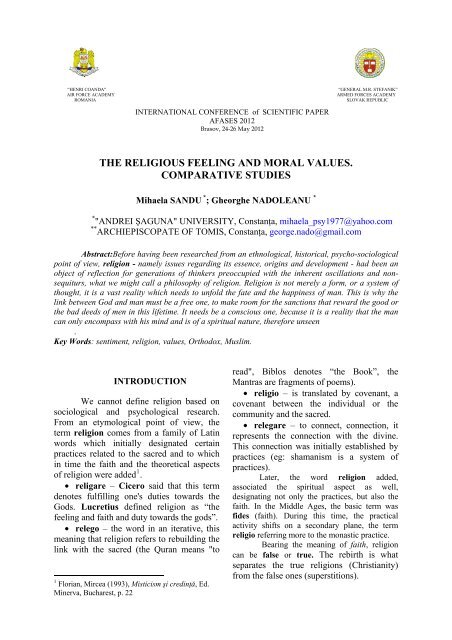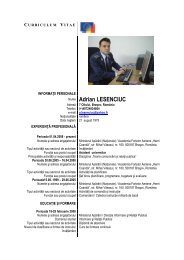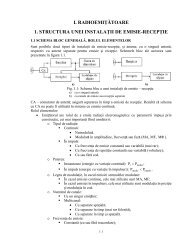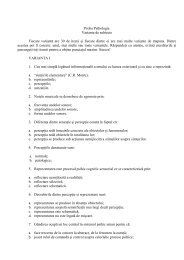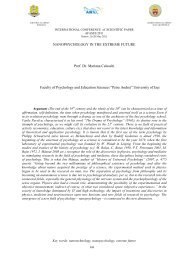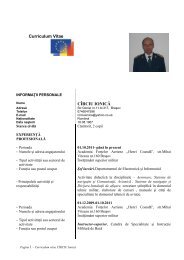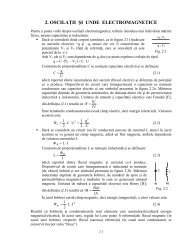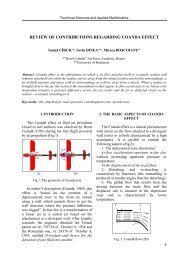SENTIMENTUL RELIGIOS ŞI VALORILE MORALE
SENTIMENTUL RELIGIOS ŞI VALORILE MORALE
SENTIMENTUL RELIGIOS ŞI VALORILE MORALE
You also want an ePaper? Increase the reach of your titles
YUMPU automatically turns print PDFs into web optimized ePapers that Google loves.
“HENRI COANDA” “GENERAL M.R. STEFANIK”<br />
AIR FORCE ACADEMY ARMED FORCES ACADEMY<br />
ROMANIA SLOVAK REPUBLIC<br />
INTERNATIONAL CONFERENCE of SCIENTIFIC PAPER<br />
AFASES 2012<br />
Brasov, 24-26 May 2012<br />
THE RELIGIOUS FEELING AND MORAL VALUES.<br />
COMPARATIVE STUDIES<br />
Mihaela SANDU * ; Gheorghe NADOLEANU *<br />
* "ANDREI ŞAGUNA" UNIVERSITY, Constanţa, mihaela_psy1977@yahoo.com<br />
** ARCHIEPISCOPATE OF TOMIS, Constanţa, george.nado@gmail.com<br />
Abstract:Before having been researched from an ethnological, historical, psycho-sociological<br />
point of view, religion - namely issues regarding its essence, origins and development - had been an<br />
object of reflection for generations of thinkers preoccupied with the inherent oscillations and nonsequiturs,<br />
what we might call a philosophy of religion. Religion is not merely a form, or a system of<br />
thought, it is a vast reality which needs to unfold the fate and the happiness of man. This is why the<br />
link between God and man must be a free one, to make room for the sanctions that reward the good or<br />
the bad deeds of men in this lifetime. It needs be a conscious one, because it is a reality that the man<br />
can only encompass with his mind and is of a spiritual nature, therefore unseen<br />
.<br />
Key Words: sentiment, religion, values, Orthodox, Muslim.<br />
INTRODUCTION<br />
We cannot define religion based on<br />
sociological and psychological research.<br />
From an etymological point of view, the<br />
term religion comes from a family of Latin<br />
words which initially designated certain<br />
practices related to the sacred and to which<br />
in time the faith and the theoretical aspects<br />
of religion were added 1 .<br />
• religare – Cicero said that this term<br />
denotes fulfilling one's duties towards the<br />
Gods. Lucretius defined religion as “the<br />
feeling and faith and duty towards the gods”.<br />
• relego – the word in an iterative, this<br />
meaning that religion refers to rebuilding the<br />
link with the sacred (the Quran means "to<br />
1 Florian, Mircea (1993), Misticism şi credinţă, Ed.<br />
Minerva, Bucharest, p. 22<br />
read", Biblos denotes “the Book”, the<br />
Mantras are fragments of poems).<br />
• religio – is translated by covenant, a<br />
covenant between the individual or the<br />
community and the sacred.<br />
• relegare – to connect, connection, it<br />
represents the connection with the divine.<br />
This connection was initially established by<br />
practices (eg: shamanism is a system of<br />
practices).<br />
Later, the word religion added,<br />
associated the spiritual aspect as well,<br />
designating not only the practices, but also the<br />
faith. In the Middle Ages, the basic term was<br />
fides (faith). During this time, the practical<br />
activity shifts on a secondary plane, the term<br />
religio referring more to the monastic practice.<br />
Bearing the meaning of faith, religion<br />
can be false or true. The rebirth is what<br />
separates the true religions (Christianity)<br />
from the false ones (superstitions).
The definition of religion, according<br />
to Durkheim, is the following: “Religion is a<br />
solitary system of faiths and practices<br />
related to the sacred” 2 .<br />
The religious feeling is defined as<br />
"purity, veneration and piety", "reasoning for the<br />
affective evaluation of an invisible world",<br />
"mental faculty or disposition which,<br />
independent or in spite of the senses and of<br />
reason, makes the human being capable of<br />
feeling the infinite under various names and<br />
divine disguises" 3 .<br />
The man as an individual or as a<br />
member of the family or of society needs<br />
religion. Through it, man knows God as the<br />
source of truth and as norm of the moral life,<br />
bringer of happiness. Through religion, man<br />
becomes confident with his deeds and rises<br />
above the creatures living around him.<br />
Man has the religious feeling as<br />
something more than any other living<br />
creature. And if Aristotle called the human<br />
being a social animal, modern later<br />
anthropology calls man a religious animal.<br />
Religion is necessary for the family and for<br />
society as a whole and the fact that those<br />
who want to hurt the institution of family or<br />
society itself start by hurting the religious<br />
feeling, and those who want the social<br />
nucleus, family, to gain prestige, talk about<br />
the absolute utility of religion.<br />
The value we believe in and that we<br />
cherish ask us to choose and praise those<br />
forms of conduit which sustain and help<br />
spread in the whole world the values that<br />
deserve to exist, and to avoid, despise and, if<br />
possible, to decimate those deeds which<br />
undermine our values. Unfortunately, the<br />
next step is a more difficult one.<br />
"What are values?" - here is a question<br />
whose answer is not easy to find, although<br />
we are dealing with a pretty common word<br />
in the daily vocabulary. In the first instance,<br />
values appear as attributes of persons, ideas,<br />
deeds, institutions or things which are<br />
important, worthy of being respected and<br />
2<br />
Durkheim, E. (1912), Les formes elementairede la<br />
vie religieuse, Paris.<br />
3<br />
Mânzat, I. (1997), Psihologia credinţei religioase.<br />
Transconştiinţa umană, Ed. Ştiinţă &Tehnică,<br />
Bucharest, p. 135.<br />
cherished, and which people consider as<br />
worthy of trying to see accomplished to the<br />
fullest extent. To put it briefly, value is<br />
important and respect-worthy. Important for<br />
whom and why?<br />
There were various answers to these<br />
questions, formulated during the ages, and<br />
each of them had pros and cons.<br />
Moral values always refer to the effects<br />
or consequences of our actions on the others<br />
or on our own selves. They define those<br />
character traits that when cultivated and,<br />
more than anything, put into practice, are<br />
capable of reining in our aggressive and<br />
antisocial impulses, stopping us from<br />
causing useless harm and unnecessary<br />
suffering but, most of all, to stimulate our<br />
attitudes of solidarity with the others in such<br />
a way that our deeds lead to the full<br />
affirmation of the humanity within ourselves<br />
and within our fellow men.<br />
Factors influencing the religious life<br />
The religious life of communities of<br />
believers is not subject to a casual<br />
determinism. There is a plurality of factors<br />
which influence it and their role modifies<br />
according to age, culture and geographic<br />
areas. Thus we have a model of added values<br />
which influence in a very diverse manner the<br />
confessional distribution and intensity of the<br />
religious life.<br />
It has been attempted to define the<br />
fundamental or unique cause which<br />
determines the religious life. The purpose<br />
was to influence this cause and to manipulate<br />
the believers and the religious life.<br />
During the communist times, had they<br />
been able to discover the cause of man's<br />
faith, it would have been very easy to<br />
eliminate it. But faith is determined by a<br />
large number of social, natural, personal<br />
factors, each of them modifying its role<br />
during the life of the man of faith.<br />
The religious life varies, depending upon<br />
one's natural environment, political system,<br />
economic situation, place of living, social<br />
events, culture etc. All these factors<br />
influencing the religious life are assimilated<br />
by the believers through their own social<br />
filter, i.e. the family, school, culture that<br />
encompass the individual.
“HENRI COANDA” “GENERAL M.R. STEFANIK”<br />
AIR FORCE ACADEMY ARMED FORCES ACADEMY<br />
ROMANIA SLOVAK REPUBLIC<br />
INTERNATIONAL CONFERENCE of SCIENTIFIC PAPER<br />
AFASES 2012<br />
Brasov, 24-26 May 2012<br />
The natural environment has a bigger<br />
religious influence both upon the individual and<br />
upon populations in the incipient periods.<br />
Natural factors mostly influence the child<br />
and the archaic population. Nature influences<br />
the religious feeling by means of<br />
impressionability. Man notices the<br />
complexity of nature, is incited by the<br />
landscape, by the social order and harmony,<br />
because ever since childhood it was taught to<br />
him that it was all the hand of God. The<br />
evolution in terms of age decreases the role<br />
of the social environment in the religious<br />
life. It has been noted that the natural<br />
environment mostly influences boys. Natural<br />
phenomena (earthquakes, thunders, storms)<br />
predominantly influence girls, who attribute<br />
these manifestations to the sacred.<br />
Family plays a fundamental role in forming a<br />
religious life in the first part of childhood (up to<br />
14 years of age). Family, mostly the<br />
grandparents in the modern society,<br />
transmits the religious model to the children.<br />
Family acts upon children by means of:<br />
family atmosphere, family practices,<br />
religious education, family events. For the<br />
child religiosity is not something distinct and<br />
specialized, it is identified with the entire<br />
spiritual life (God is good, God is right, God<br />
is beautiful, God rewards them or God<br />
punishes them). It has been observed that the<br />
downfall of authority in families pushes<br />
children away from religious faith.<br />
Abandoned children, orphans, children<br />
coming from broken homes are more easily<br />
convertible to other religions or atheism.<br />
The territorial community - the village, the<br />
town, the geographical area has a number of<br />
religious models that it passes down to the<br />
descendants by means of the atmosphere from<br />
that community, by practices, events within the<br />
community, all having a religious influence on<br />
people. Communities have certain traditions<br />
that influence the believers as long as they<br />
stay within the boundaries of the community.<br />
Church plays an important role in the<br />
forming of religious life, both as a place of<br />
worship and by means of the staff in churches.<br />
This personnel plays the role according to<br />
the number of believers that the community<br />
has. Priests play a less important role if the<br />
number of believers is large, or if they are<br />
located at large distances. Frequenting the<br />
house of worship is discontinuous. The<br />
quality of the church staff is that of<br />
transmitting, in time, the religious feelings<br />
and of guaranteeing a frequent presence in<br />
churches.<br />
Culture is yet another important factor in<br />
forming the religious life. The Enlightenment,<br />
the Positivist and Marxist currents have<br />
stated that the higher the culture, the lower<br />
the religious state becomes. The religious<br />
state, as a spiritual experience, is influenced<br />
both theoretically and dogmatically by the<br />
level of education and culture. As feelings, it<br />
continues to exist, no matter the level of<br />
culture. The illiterate, the intellectuals and<br />
the scientists can have the same amount of<br />
faith. Studies in this field proved that as the<br />
culture level gets higher, the peripheral<br />
religiosity is gradually eliminated and the<br />
religious experience of the true believers is<br />
consolidated.<br />
School - education implements certain<br />
spiritual values which modify the religious<br />
proportion from the affective level to the<br />
intellectual level. The modification takes place<br />
quicker in the case of boys, who reason their<br />
faith before girls and become more selective.<br />
Girls stay affective in their religiosity for<br />
longer and towards adolescence they tend to<br />
a religiosity with specific aspects (they start<br />
believing in female religious personalities:
The Virgin Mary, St. Friday etc.). Moreover,<br />
their religiosity is a more intimate one - they<br />
retreat and pray in solitude.<br />
The bio-psychic dynamics of the human<br />
personality - some psychologists and sociologists<br />
have exaggerated the personality factors in the<br />
religious life. For example, Jung when talking<br />
about extroverts and introverts, shows that<br />
the extroverts are more sociable and have a<br />
more frequent religious practice, while the<br />
introverts, oriented towards the interior, live<br />
their religious feelings more intensely, even<br />
if they express them less. Research outlined<br />
a few stages in the religious evolution of<br />
personality. There is an ascension of the<br />
religious state under the influence of family<br />
until the age of 13-14 in the industrial and<br />
developed areas. In the case of the less<br />
developed countries, this ascension<br />
continues until the age of 15-16. The period<br />
of adolescence represents a search of the<br />
religious ideal and a decline of the religious<br />
state. After 20 years the religious life<br />
recovers. During the mature years it is stable,<br />
not very intense, but the cases of conversion<br />
(confessional migration) are very rare.<br />
How age influences the religious life 4 :<br />
- until 7 years of age, the child grows<br />
within the family and adopts the religious<br />
model of the parents.<br />
- after 7 years of age the family religious<br />
ideas and beliefs are completed by the<br />
school influences. Schooling increases the<br />
theoretic aspect of religiosity, while<br />
diminishing the affective dimension.<br />
Besides the positive aspects of the<br />
religious education in schools, there is<br />
also a negative side: pushing children<br />
away from the religious experience.<br />
Students perceive Religion as a<br />
compulsory subject, ruled by grades, a<br />
schedule, exams, and all this serves to<br />
diminish the affective attachment. When<br />
no longer under supervision, children tend<br />
to avoid the practices they had complied<br />
with before.<br />
- after 13 years of age they have access to<br />
religious literature and to means of<br />
4<br />
Meslin, M. (1993), Ştiinţa religiilor, Ed. Humanitas,<br />
Bucharest, pg. 154<br />
information that bring to their attention other<br />
models besides the family religiosity and they<br />
begin to doubt the authenticity of their<br />
parents' model.<br />
- adolescence is a transition period, when the<br />
personality leaves the realm of childhood,<br />
claims the adult status which is only obtained<br />
when no longer claimed. The adolescents<br />
have the tendency to verify the<br />
authenticity and veracity of everything<br />
they had known up to that point. They<br />
exaggerate antagonism (opposition),<br />
manifested in different shapes: it can be<br />
detached from previous values, it<br />
practices a real or fictitious narcissism.<br />
From a religious point of view, the sacred<br />
and the traditional church seem as values<br />
belonging to the aged. They would like to<br />
create their own model regarding the<br />
sacred. The evasion towards the secularsacred<br />
models appear now, they admire<br />
cinema artists, musicians and people from<br />
other confessions. Some theoreticians<br />
state that this tendency towards religious<br />
evasion is formed on the basis of a lack of<br />
bio-psychical maturity.<br />
- towards 25 years of age, when an adult, the<br />
person becomes religiously stable, the<br />
religious and spiritual influences affect him or<br />
her less. They generally return to the<br />
religious life from their previous family.<br />
During this time the religious practices<br />
are lower, so is the religious extremism,<br />
the adult perceives the church more as an<br />
institution.<br />
- the third age reawakens the preoccupations<br />
related to religiosity. More than anything it<br />
is faith that grows bigger, the religious<br />
practices aren't extraordinary intense. The<br />
reasons why the practices are thus<br />
restrained belong to the secular (people<br />
are old and can no longer often get to<br />
church, are ill etc.).<br />
The affective dimension of religiosity<br />
(faith)<br />
The religious life is accomplished in<br />
several correlated dimensions, but some can<br />
be more emphasized or more diminished.<br />
For example, some believers may be more<br />
intensely religious, without having an<br />
accentuated practical externalization as
“HENRI COANDA” “GENERAL M.R. STEFANIK”<br />
AIR FORCE ACADEMY ARMED FORCES ACADEMY<br />
ROMANIA SLOVAK REPUBLIC<br />
INTERNATIONAL CONFERENCE of SCIENTIFIC PAPER<br />
AFASES 2012<br />
Brasov, 24-26 May 2012<br />
compared to others, with less faith, who<br />
frequent church on a more regular basis.<br />
Faith is the affective dimension of<br />
religiosity. Even in the current times there<br />
are theologians who consider that the<br />
religious feeling is born in man, as a gift<br />
from God. Man has set himself apart from<br />
other living creatures by moral feelings and<br />
religious feelings.<br />
In reality people are born and acquire<br />
predispositions which in contact with the<br />
religious models become religious feelings.<br />
Faith is defined as a power, a<br />
confidence that turns what we wish for into<br />
something that exists. Paul the apostle said in<br />
his letter to the Jews: "faith is the entrusting<br />
(confidence) in what one hopes for". (Jews<br />
11:1). This confidence encompasses some<br />
certainties:<br />
- God exists.<br />
- God influences the world, the man,<br />
the everyday life.<br />
- A relationship with God is possible.<br />
These certainties form in the believer<br />
the psychic state of dependency towards<br />
God. Being aware of certain religious<br />
models, this dependency transforms into a<br />
psychological need. In the centre of this need<br />
lies the conviction that God is sublime. The<br />
sentiment of guilt (sin) and the expiatory<br />
(salvation) wish appear.<br />
The religious feeling is defined as "purity,<br />
veneration and piety", "reasoning for the<br />
affective evaluation of an invisible world",<br />
"mental faculty or disposition which,<br />
independent or in spite of the senses and of<br />
reason, makes the human being capable of<br />
feeling the the infinite under various names and<br />
divine disguises".<br />
The man as an individual or as a<br />
member of the family or of society needs<br />
religion. Through it, man knows God as the<br />
source of truth and as norm of the moral life,<br />
bringer of happiness. Through religion, man<br />
becomes confident with his deeds and rises<br />
above the creatures living around him.<br />
Man has the religious feeling as<br />
something more than any other living<br />
creature. And if Aristotle called man a social<br />
animal, the modern anthropology calls him a<br />
religious animal. Religion is necessary for<br />
the family and for society as a whole and the<br />
fact that those who want to hurt the<br />
institution of family or society itself start by<br />
hurting the religious feeling, and those who<br />
want the social nucleus, family, to gain<br />
prestige, talk about the absolute utility of<br />
religion.<br />
Religious feelings can be amplified or<br />
diminished by correlating them with the events<br />
in their lifetime or in contact with art. The<br />
diminishing of the religious feeling can reach<br />
to atheism. Extracting normal religious<br />
feelings may create states of social<br />
disintegration. Religious disintegration may<br />
take two forms for psychologists:<br />
- religious passion.<br />
- religious insanity.<br />
Religious passion is socially manifested as<br />
fanaticism, fundamentalism and it engulfs the<br />
life of the individual who neglects other social<br />
obligations. Passion can be of two kinds:<br />
bigot - the bigot is a very gullible person,<br />
with a pure soul and who wants salvation<br />
at any cost. The bigot is excessively<br />
pious, the rituals he or she practices are<br />
meticulous. However, bigots lack<br />
judgement, which makes it easy to<br />
manipulate them.<br />
mystic - the mystics are maniacs who can<br />
manifest themselves either periodically<br />
(under the form of seizures), or<br />
permanently. The mystic becomes one<br />
with the divine, his visions tend to
seem to him more real than the actual<br />
truths.<br />
Religious insanity occurs when the<br />
believer manifests a permanent ecstasy, either<br />
passive (as is the case of Hinduism and<br />
Buddhism), or hysteric. The cases of religious<br />
hysteria are dangerous. Religious insanity<br />
can have two forms:<br />
theomania - in the case of theomania,<br />
the individual becomes one with God,<br />
thinks himself to be God or His Chosen<br />
One. Sometimes these individuals can<br />
be dangerous as well.<br />
demonomania - in the case of<br />
demonomania, the believer considers<br />
himself as possessed by the devil and<br />
commits devilish deeds, such as:<br />
vampirism, lycanthropy (the patient<br />
believes he has turned into an animal),<br />
erotomania (girls thought they could only<br />
have sexual intercourse with the devil).<br />
Such cases are treated by Church<br />
through exorcism.<br />
The religious faith has a fundamental<br />
dimension of the spirit which can be expressed in<br />
a table of values. Faith is not an act of<br />
intellectual consent towards certain<br />
assertions, but moral commitment which<br />
involves the complete integration in a whole<br />
of both the intellectual consent and an<br />
infinite trust.<br />
Research Objectives<br />
This study aims to highlight the<br />
intensity of the religious feeling and to<br />
identify the moral values of the study<br />
participants. It also aims to emphasize a<br />
possible relationship between the religious<br />
feeling and the moral values, as well as to<br />
highlight certain differences between the<br />
participants of Orthodox confession and<br />
Frequency Percentage<br />
Valid female 39 48.8<br />
male 41 51.3<br />
Total 80 100.0<br />
those of Muslim confession as far as the<br />
religious feeling is concerned.<br />
Specific objectives:<br />
- to evaluate the intensity of the<br />
religious feeling with persons<br />
belonging to the Orthodox and the<br />
Muslim confessions.<br />
- to identify the moral values of the<br />
study participants;<br />
- to emphasize significant relationships<br />
between the religious feeling and the<br />
moral values of the study<br />
participants;<br />
- to highlight the significant<br />
differences between the Orthodox<br />
and the Muslim participants<br />
according to the religious feeling.<br />
Research Hypotheses<br />
Hs. 1. It is presumed that the moral values<br />
adopted by the Orthodox participants are<br />
oriented towards freedom, honesty,<br />
education and independence, and those<br />
adopted by the Muslim participants are<br />
oriented towards altruism, tolerance, respect<br />
and responsibility.<br />
Hs. 2. It is presumed that there are<br />
significant relationships between the<br />
religious feeling and the moral values of the<br />
Orthodox and Muslim participants.<br />
Hs. 3. It is presumed that there are<br />
significant differences between the Orthodox<br />
and the Muslim participants in the intensity<br />
of religious feeling.<br />
Study Participants<br />
Table 1. Frequency table for the "biological<br />
gender" variable<br />
This study involved 80 subject, 39<br />
women and 41 men, both Orhtodox and<br />
Muslim. By analysing the sampled subjects<br />
from the perspective of the "age" variable,<br />
this varies between 19 and 62 years of age,<br />
the biggest frequency is that of the subjects<br />
who are 35 years old. The average age of the<br />
study participants is of 43.05 years.<br />
Instruments used<br />
The Questionnaire for Assessing the<br />
Religious Feeling (Chestionarul de<br />
evaluare a sentimentului religios -<br />
C.E.S.R.) -is made up of 37 items and it<br />
addresses the Christian population in<br />
Romania, over 18 years of age. The religious<br />
feeling assesses the extent to which the<br />
individual got closer of further from divinity<br />
and expresses the degree of intensity of the<br />
religious life.<br />
For the purpose of this study we built a<br />
Questionnaire for Assessing the Moral Value<br />
(Chestionar de valori morale - C.V.M.) - is
“HENRI COANDA” “GENERAL M.R. STEFANIK”<br />
AIR FORCE ACADEMY ARMED FORCES ACADEMY<br />
ROMANIA SLOVAK REPUBLIC<br />
INTERNATIONAL CONFERENCE of SCIENTIFIC PAPER<br />
AFASES 2012<br />
Brasov, 24-26 May 2012<br />
made up of 20 items representing values that<br />
reflect the positive or the negative aspects of<br />
morality.<br />
To validate this questionnaire we used<br />
the aspect validation method and for finding<br />
fidelity we used the test-retest method (r =<br />
0.834, p
Table 4. Comparison of the means<br />
between the<br />
scores obtained for the religious feeling<br />
Religion N Media<br />
feeling Orthodox F Sig.<br />
sentime Dispersie<br />
42 102.60<br />
omogena<br />
Muslim 38 133.03<br />
Dispersie<br />
eterogena<br />
The statistical analysis has allowed for<br />
the identification of significant differences<br />
between the Orthodox and the Muslim<br />
participants, from the point of view of the<br />
religious feeling. The t test for independent<br />
samples (t(78) = -15.974, p < 0.01)<br />
statistically argues in favour of this<br />
hypothesis. It can be noted that the value of t<br />
test is negative because the Muslim<br />
participants scored higher as far as the<br />
religious feeling is concerned, which means<br />
that they have a favourable attitude toward<br />
religion, have a knowledge and self<br />
awareness of religious nature, are closer to<br />
divinity and express a higher degree of<br />
internalization of religious ideas. This also<br />
concerns the religious training of the<br />
individual, in the Muslim environment if the<br />
man of the family is a religious one, he<br />
imposes the religious practices and devotion<br />
upon the other family members as well.<br />
The Orthodox participants also have a<br />
religious feeling, but of a lower intensity<br />
than the Muslim ones. The Orthodox are<br />
more independent as far as practices and the<br />
individual religious devotion are concerned,<br />
they are subject only to their conscience on<br />
theological considerations.<br />
Conclusions<br />
Independent Samples Test<br />
stul Levene pent<br />
alitatea dispersiil<br />
testul t pentru egalitatea mediilor<br />
t df<br />
diferenta<br />
ig. (2-tailedmediilor<br />
1.988 .163 -15.974 78 .000 -30.431<br />
-16.047 77.989 .000 -30.431<br />
Based upon the methodological<br />
approach we may state that the hypotheses<br />
have been confirmed. Thus, the Orthodox<br />
participants showed high frequencies for the<br />
answer variants: "important" and "very<br />
important" for the following values:<br />
freedom, honesty, patience, education,<br />
independence, while the Muslim participants<br />
have had more frequent choice of the same<br />
answer variants for values such as: kindness,<br />
love for one's fellow man, love for one's<br />
family, respect, tolerance, love towards<br />
living creatures and responsibility.<br />
The Orthodox participants adopted<br />
values based on freedom, honesty, patience,<br />
education and independence, and the Muslim<br />
participants adopted values based on respect,<br />
responsibility, tolerance, love of family and<br />
fellow men, as well as towards living<br />
creatures, based on altruism and<br />
responsibility, because they are raised in a<br />
spirit of responsibility, especially in the case<br />
of men, with a high respect towards the<br />
family and especially towards the elderly.<br />
Regarding the confirmation of the two<br />
hypotheses it should be noted that between the<br />
religious feeling and the moral values integrated<br />
by the participants there is a direct and reciprocal<br />
relationship, i.e. a religious feeling of moderate<br />
to high moral intensity leads to the adoption of<br />
moral values expressing certain general<br />
requirements that are necessary for the<br />
participants' behaviour for an orientation towards<br />
the human ideal.<br />
Based on previous results, we can<br />
appreciate that the third hypothesis was also<br />
confirmed, showing that there are significant<br />
differences between the Orthodox and the<br />
Muslim participants regarding the religious<br />
feeling. The Muslim participants have a<br />
stronger religious feeling than the Orthodox<br />
ones, meaning that they have a favourable<br />
attitude towards religion, have religious<br />
knowledge and a religious conscience, are<br />
closer to the divine and express a higher<br />
degree of internalisation of the religious<br />
ideas. This also concerns the religious<br />
training of the individual, in the Muslim<br />
environment if the man of the family is a<br />
religious one, he imposes the religious<br />
practices and devotion upon the other family<br />
members as well.<br />
The values we believe in and that we<br />
cherish ask us to choose and praise those<br />
forms of conduit which sustain and help<br />
spread in the whole world the values that<br />
deserve to exist, and to avoid, despise and, if<br />
possible, to decimate those deeds which<br />
undermine our values.<br />
In the modern world, still very diverse, but<br />
slowly becoming more integrated by the process
“HENRI COANDA” “GENERAL M.R. STEFANIK”<br />
AIR FORCE ACADEMY ARMED FORCES ACADEMY<br />
ROMANIA SLOVAK REPUBLIC<br />
INTERNATIONAL CONFERENCE of SCIENTIFIC PAPER<br />
AFASES 2012<br />
Brasov, 24-26 May 2012<br />
of globalisation, given both the weakening of the<br />
authority of local and traditional customs, and<br />
the great religious diversity, moral values tend to<br />
exert an increasingly coordinating and<br />
hierarchical role within the sphere of all values.<br />
This trend is still very feeble, due to<br />
competition with other dominant or<br />
hegemonic values. Religion has been the<br />
coordinating axis of the axiological spectrum<br />
for so long, but the world has started bowing<br />
to other "gods": profit, economical interests,<br />
the production and accumulation of material<br />
wealth, in close connection with science,<br />
which, on the one hand, has offered through<br />
the technical revolution increasingly efficient<br />
means of economical growth and progress in<br />
the sphere of utilities, while on the other<br />
hand usurping religion's supremacy on the<br />
plane of spiritual living, becoming itself, for<br />
many laymen, a true religion.<br />
Bibliography<br />
1. Florian, M. (1993), Misticism şi credinţă,<br />
Ed. Minerva, Bucharest.<br />
2. Durkheim, E. (1912), Les formes<br />
elementairede la vie religieuse, Paris.<br />
3. Durkheim, E. (1997), Formele elementare<br />
ale vieţii religioase, Editura Antet Press,<br />
Bucharest.<br />
4. Mânzat, I. (1997), Psihologia credinţei<br />
religioase. Transconştiinţa umană, Ed.<br />
Ştiinţă & Tehnică, Bucharest, Muller, M.<br />
(1892), Anthropological Religion,<br />
London.<br />
5. Meslin, M. (1993), Ştiinţa religiilor, Ed.<br />
Humanitas, Bucharest


